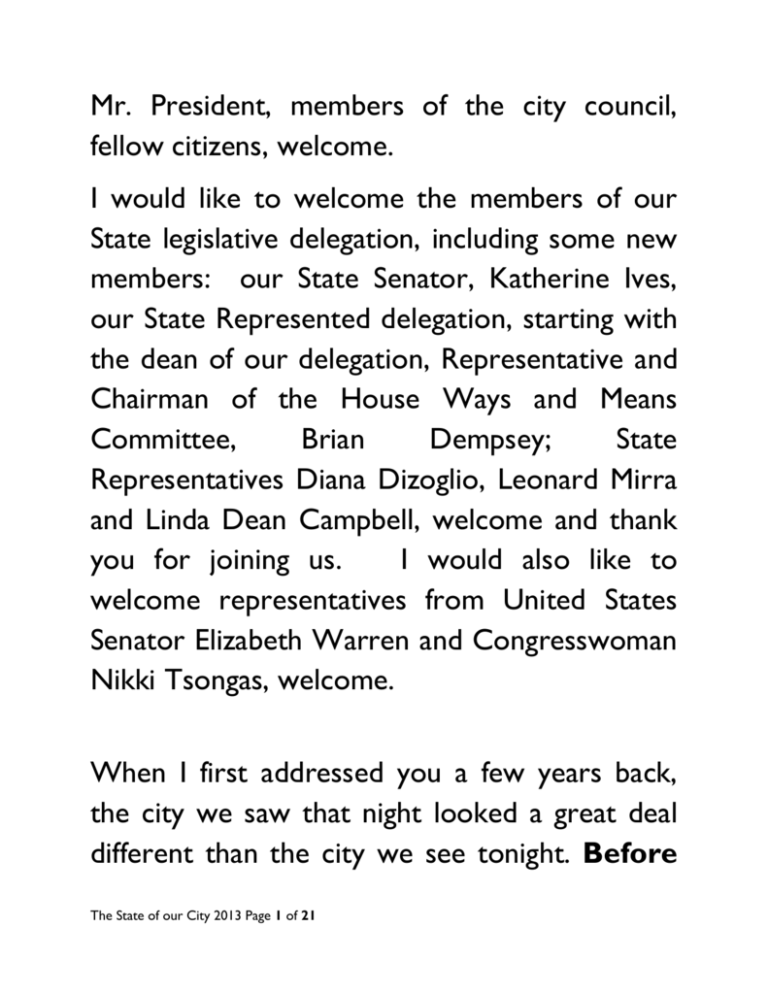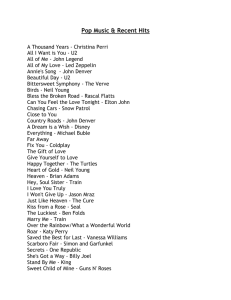State of the City Address
advertisement

Mr. President, members of the city council, fellow citizens, welcome. I would like to welcome the members of our State legislative delegation, including some new members: our State Senator, Katherine Ives, our State Represented delegation, starting with the dean of our delegation, Representative and Chairman of the House Ways and Means Committee, Brian Dempsey; State Representatives Diana Dizoglio, Leonard Mirra and Linda Dean Campbell, welcome and thank you for joining us. I would also like to welcome representatives from United States Senator Elizabeth Warren and Congresswoman Nikki Tsongas, welcome. When I first addressed you a few years back, the city we saw that night looked a great deal different than the city we see tonight. Before The State of our City 2013 Page 1 of 21 the great recession, we faced the largest municipal debt in the 350 year history of Massachusetts and the very real prospect that we would go into receivership. When I first addressed you, our reserves were depleted, our bond rating was tied for the lowest in the State, our high school needed millions of dollars that we did not have for repairs just to keep its accreditation, and not a single old factory building had been rehabbed in decades. When I first spoke to you, our goals were very modest—survive and avoid receivership. Tonight, we see a very different picture. Less than a decade later, our state of the art high school is fully restored, at a small fraction of the cost paid by other cities. Our bond rating has gone up twice, and today stands at its highest level in a decade. This past year the The State of our City 2013 Page 2 of 21 bond rating companies also raised our bond outlook. Tonight, old factory buildings stand proud as new housing, investors want to build a new boutique hotel in our city. I am here to report tonight on our success but, also to outline a plan and vision for tomorrow so that our best days will lie ahead. Our success did not happen by accident. It happened because all of us, including the folks in this room, had a vision, a plan and worked together to make that plan a success. Turning the city around required us first and foremost to hold the line on spending. This wasn’t always easy, there were bumps and heated arguments along the road, but we held firm, and refused to spend what we did not The State of our City 2013 Page 3 of 21 have. Our budget increases were less than half what they had been in other administrations and over the years, we cut 26% of our workforce and asked our employees to do more with less and to their credit they did. When we were done, we had the lowest number of employees per capita of any city our size in the State, no one else even came close. Then we asked our employees to work with us to achieve new health care savings. Last year alone we saved $1.1 million in health care costs, an over the years, we have saved $11 million –by changing health care plans. Tonight, I thank our employees for their sacrifices and for working with us over the years: I know it has not been easy, but your hard work and sacrifice has not gone unnoticed and is deeply appreciated. The State of our City 2013 Page 4 of 21 A key part of our success over the years has been the help we have received from the State. Over the years, the State has contributed over $9 million to help pay the Hale debt. We thank our state delegation—past and present-- and particularly State Representative Dempsey— whose work was critical to our success. The third part of our plan to turn Haverhill around, and the one I want to concentrate on this evening, was to use zoning as a positive tool to bring more investment to our city, and rebuild our tax base. We rezoned downtown to become the first city in the State to encourage new housing near train stations. Then we rezoned the outskirts of the city to allow for big box retail stores. Downtown rezoning brought in over $150 million of new private and public investment in our downtown; 850 new residents and a The State of our City 2013 Page 5 of 21 number of new restaurants including two that opened just this past year,— Butch’s Uptown, and the Barking Dog Ale House. Tonight, I announce that have a new restaurant and sports pub opening downtown, in the spot where the Hotel Whittier once stood, called Coaches and I would like to welcome the owners here today, Charles Defelice, Joan and Jodi Kaskiewics. This new investment in our downtown has brought in $4.6 million in new real estate property taxes and $2 million in new meals tax revenues over the years—revenue that was crucial to keeping our city safe and affordable. Rezoning of the outskirts of the city brought in an additional five and a half million dollars in new tax revenues. The State of our City 2013 Page 6 of 21 Altogether, rezoning and the meals tax revenues, brought in a total of $12 million over the years. We know that rezoning can work in bring in new investment—it doesn’t always work, but it can work. We need to learn from our success. Tonight, I announce a series of new zoning initiatives that will give us the tools to expand our success to the waterfront, to our industrial parks and to the Little River. This second phase of rezoning plans already started when we announced, and the council adopted, our plans to rezone Merrimack Street. We have already come a long way downtown, but there is more to come. We are excited that Rep. Dempsey and Chancellor Meehan are bringing a branch of U-Mass Lowell to downtown to open as early as this fall. The State of our City 2013 Page 7 of 21 Last year, the Massachusetts legislature adopted a new law, called general laws chapter 40V, to encourage market rate housing downtown. Next week, I will ask the city council to adopt that new law and to designate Merrimack Street and parts of Bradford as our 40V district, to encourage market rate housing in our downtown and along the Merrimack. Then, next month, I will ask the city council to work with me to rezone the north side of Merrimack Street to allow for artists’ lofts on the upper floors. Our rezoning initiatives start downtown, but they cannot end there. If we want our city to thrive we need to use the zoning lessons we learned downtown in other areas of our city. We need to start along the banks of the Merrimack River. The State of our City 2013 Page 8 of 21 The Merrimack River is our most precious asset, and has been from the time the first settlers first used it to navigate here. Within the next few weeks, I will introduce a zoning plan to rezone both sides of the Merrimack, to encourage investment in these areas, and to make certain that the public always has access to the river. The riverfront zoning plan will divide the areas along the river into seven (7) zones with a separate plan for each zone. We will start in the old factory areas on the Bradford side of the river, in areas where workers once worked at places like Hoyt and Worthen Tanning, Ornsteen Heel and the Haverhill Paperboard. Those areas are still zoned for industrial use—but industry moved long ago to the industrial parks. We need to The State of our City 2013 Page 9 of 21 update our zoning laws to keep pace with the new economic reality. Next month I will ask the council to rezone those areas, so that someday these areas can see revitalization much as the old factory buildings downtown did. These old industrial zones include one property that the city owns, an abandoned site where hundreds of workers once worked at the Ornsteen Heel Factory. Next month, the city will put out a request for proposals, to encourage a public private partnership that will allow redevelopment of that parcel so long as the developer will allow all of our citizens to have access to the river. The rezoning plans that I announce this evening will have a different look for each of the seven zones along the river. On Water Street, we will encourage residential, retail and mixed use. The State of our City 2013 Page 10 of 21 Along the rail trail in Bradford, we will encourage residences and businesses. On Merrimack Street, we encourage retail, commercial and mixed use. The zones are different, but there is one constant. If you allow for public access, we will eliminate red tape and regulatory barriers because the river belongs to all of us. The Merrimack River is our greatest asset, but it is not our only asset or our only river. We have a second great asset, known as the Little River. Little River was once its own center of commerce and industry. The city’s first mill building, a cotton mill, started there in 1800. Thousands of people once worked in places with names like Hale’s Factory, and Clark’s Mill and, in later years, in places like Little River Dyers, but over the years, the buildings along The State of our City 2013 Page 11 of 21 Little River have fallen into disrepair. These abandoned fire traps add nothing in jobs and little in tax revenues. In the next few months, I will ask the city council to rezone Stevens Street along Little River and to extend our transit oriented development zone to that area. Tonight we have with us the first of what we hope are series of investors interested in redeveloping Little River. I am happy to introduce Richard Relich and Colin O’Keeffe from the Boston firm of Arch Street Development LLC, who have expressed an interest in a multimillion dollar development along Little River in the Stevens Street mill. This development has a long way to go to conclusion, but if it occurs, it will redevelop that district just as the old factory buildings were redeveloped. The State of our City 2013 Page 12 of 21 These rezoning plans are only the start. We need to look at every zone of our city, to see which areas we want to preserve and which areas and want to encourage investment. In the next few weeks, I will appoint a new zoning advisory committee, to to take a new look at zoning beside the highways, to look at our laws on cluster zoning and examine new tools to protect our environment, like low impact development, to help us to encourage investment in our city while still preserving our natural resources. New investment brings new revenues and new jobs, but it does something even more important. It helps to keep our city affordable and improve the quality of life for all of our citizens. The State of our City 2013 Page 13 of 21 When we started, the tax bills for the average single family residential taxpayer were well above the State average. Today, the average single family residential tax bill is well below the State average and among the lowest in Essex County. Our improved financial position has also helped us to improve the quality of life for our citizens. Today, our schools have improved, our parks and playgrounds are better, our city is cleaner and safer but there is more to do. We must start with public safety, but because the first job of government is to keep its citizens safe. We have consistently asked our police department to do more with less and they have. Today, thanks to the hard work of the men and women in that department, I can report that for the second year in a row crime The State of our City 2013 Page 14 of 21 is down. Over the past two years, overall crime in Haverhill was down 13%-- which translates into hundreds of fewer crimes. Quality of life crimes are down even more, burglaries are down 52% over the past two years. None of this happened by accident. It happened because the Haverhill Police department was proactive, they increased police patrols in inner city areas, worked with the kids in our gang resistance program and worked proactively to keep us safe. But we know there is more to do. This year, we swore in three new police officers, we are honored to have them here this evening, I would ask them to stand and be recognized. Tonight I announce that we are going to be adding to our force and next month I will ask the council to approve a supplemental budget to add two more officers to our force. The State of our City 2013 Page 15 of 21 Improving the quality of life has to include improving the quality of public education. Over the years, we’ve spent over $43 million on capital improvements to our high school and school buildings throughout the city. This year we are spending $6 million to make improvements to our middle and elementary schools. There is one school that cannot be so readily fixed—the Hunking School. We are in the process of doing a feasibility study for a new school, and if the study confirms that a new school is needed, next year we will ask our voters to allow us to build a new school in Bradford. This is not just an education issue; it is an issue that affects all of our property values and one that we all need to support. But the most important thing that happens in education isn’t what happens to the building, it The State of our City 2013 Page 16 of 21 is what happens inside the building. Over the years, our math scores are up 13% our graduation rate is up, and our dropout rate is down, but we have more to do. This year, thanks to the hard work of Superintendent Scully, we have a renewed emphasis on academics. Using Federal grant money, 550 students who need help are being tutored after school to improve their MCAS results. Our midyear testing, shows we are making progress but we know there is more to do. Our success as a city depends on having a great education system. We need to expand our summer school program and make it mandatory and we need to expand our tutoring program so that it includes in school tutoring. Our plan to improve the quality of life of our citizens has to include our senior citizens. We The State of our City 2013 Page 17 of 21 know that many of our senior citizens use our citizens’ center and this spring, we will start with a series of improvements to our Citizen’s Center. Improving our quality of life means improving our parks and playgrounds. In the past few years, we have made brought swing sets back to our playgrounds, we’ve installed new bathrooms and last year, the George Washington Landing Park in Bradford became our first new playground in decades. This year, we’ll do even more. Tonight, I announce the Park Improvement Program to make improvements in parks and playgrounds throughout the city. At Swasey Field, thanks to a State grant and to our own community development money, we will install a new spray and splash park, put in new ball fields and a new walking trail. At The State of our City 2013 Page 18 of 21 Portland Street we will upgrade the playground equipment, and later this year, I will ask the Council to approve appropriations to make improvements to Riverside Park and to GAR Park. But it is along the waterfront where our vision for an improved quality of life can make the most difference. Last year, we broke ground on a new rail trail along the Merrimack. This year, we will start on a series of improvements to that trail, to install new landscaping, new benches and a new playgrounds, and new paths for walking and biking. Our vision is that someday our children and grandchildren will enjoy their own emerald necklace of parks and walkways along the river, from the train station all the way to Groveland. The State of our City 2013 Page 19 of 21 This vision will take years, but it is a vision worth pursuing. I am reminded of the Chinese proverb that the journey of a thousand miles starts with a single step. We are taking that step now. Tonight I see a very different city than I saw just a few years ago. Tonight, in a city where I once saw young people leaving in droves, I see young people returning in droves to live in our downtown. Where I once saw a high school that was losing its accreditation, tonight I see a fully accredited state of the art high school. Where I once saw a city where business was leaving, tonight I see investors coming back to The State of our City 2013 Page 20 of 21 our city to bring new hotels, to redevelop old mill buildings and build new restaurants. Where I once saw a city on the verge of receivership, tonight I see a city on the verge of greatness. We still have our difficulties, we still have problems to face and hills to climb, but tonight, I sense a new confidence that we have done better and that we can meet the challenges. Tonight, I can confidently report to you that the state of our city is strong. And tonight I can report to you that for all of our progress, our best days lie ahead. Thank you and thank you for listening here this evening. The State of our City 2013 Page 21 of 21





